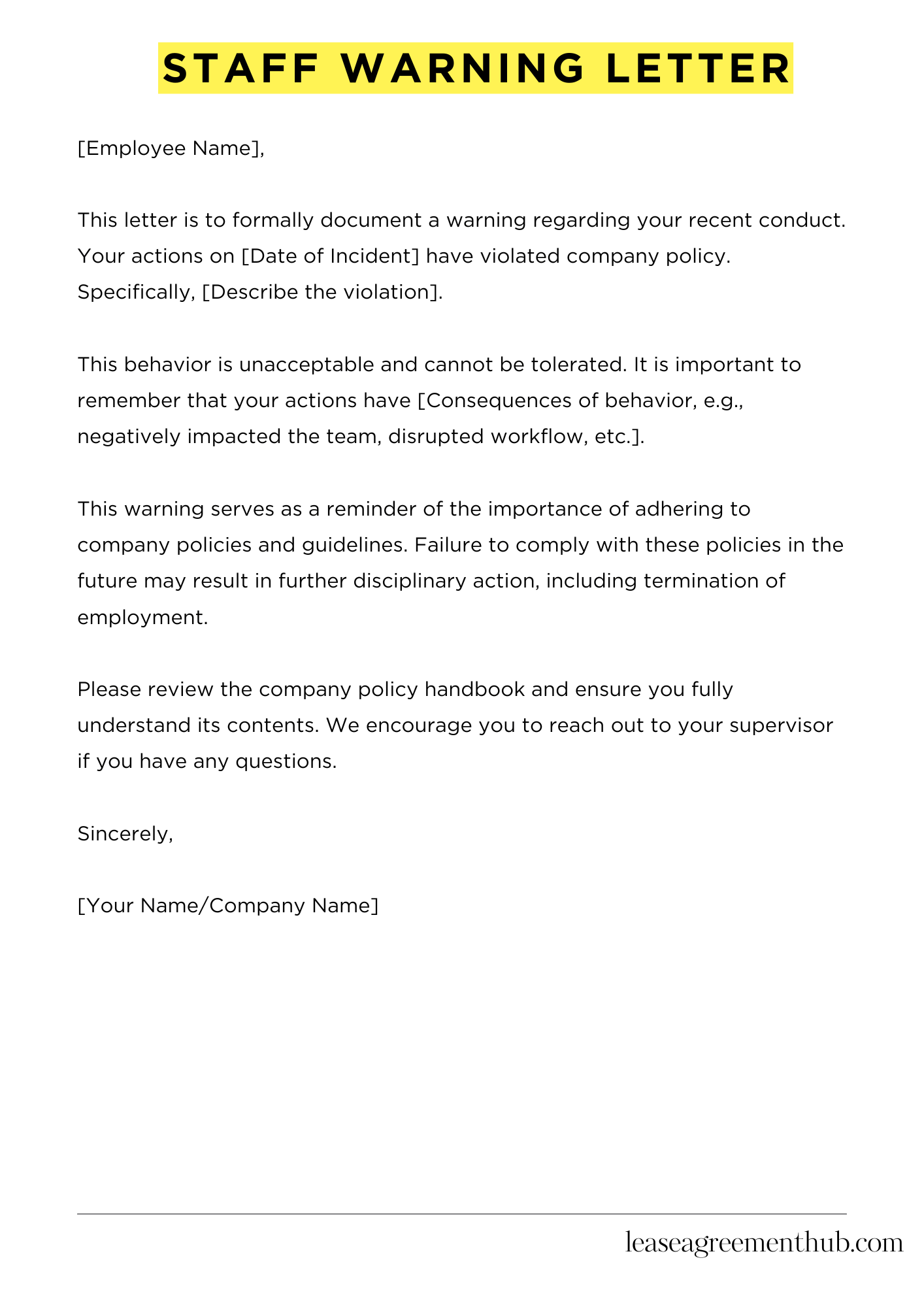A Staff Warning Letter is a formal document used by employers to address employee misconduct or performance issues. Its purpose is to inform the employee about the specific behavior that needs to change and the potential consequences of not improving. This letter serves as a crucial step in the disciplinary process, ensuring that employees understand the seriousness of their actions.
In this article, we will provide various templates and examples of Staff Warning Letters. These samples are designed to help you easily create your own letters. Whether you need to address attendance problems, performance issues, or behavioral concerns, we have you covered.
By using our templates, you can save time and ensure that your message is clear and professional. Writing a warning letter can be daunting, but our examples will guide you through the process. You’ll be able to communicate effectively while maintaining a respectful tone.
Staff Warning Letter
[Employee Name],
This letter is to formally document a warning regarding your recent conduct. Your actions on [Date of Incident] have violated company policy. Specifically, [Describe the violation].
This behavior is unacceptable and cannot be tolerated. It is important to remember that your actions have [Consequences of behavior, e.g., negatively impacted the team, disrupted workflow, etc.].
This warning serves as a reminder of the importance of adhering to company policies and guidelines. Failure to comply with these policies in the future may result in further disciplinary action, including termination of employment.
Please review the company policy handbook and ensure you fully understand its contents. We encourage you to reach out to your supervisor if you have any questions.
Sincerely,
[Your Name/Company Name]

How to Write a Staff Warning Letter
Writing a staff warning letter can be a daunting task. It’s a formal document that outlines an employee’s misconduct and the potential consequences if the behavior doesn’t change. It’s crucial to get it right, ensuring clarity, professionalism, and a focus on improvement. This guide will walk you through the process of crafting an effective warning letter.
1. Understand the Purpose
A warning letter serves as a formal record of an employee’s unacceptable behavior. It’s a chance to address the issue directly, outline expectations for improvement, and inform the employee of the potential consequences if their behavior continues. This letter should be clear, concise, and focused on the specific issue at hand.
2. Gather the Facts
Before you start writing, ensure you have all the necessary information. This includes specific details about the incident, dates, times, and any witnesses. You should also have a clear understanding of your company’s policies and procedures regarding disciplinary action. Don’t rely on hearsay or assumptions.
3. Structure the Letter
A well-structured warning letter will be easy to understand and follow. It should include the following sections:
- Introduction: Start by clearly stating the purpose of the letter, mentioning the employee’s name and position.
- Description of the Incident: Provide a detailed and objective account of the specific incident or behavior that led to the warning. Be specific and avoid vague or subjective language.
- Company Policies: Clearly state the relevant company policies and procedures that the employee has violated.
- Expectations for Improvement: Outline the specific steps the employee needs to take to correct their behavior. Be clear about what is expected of them and by when.
- Consequences: Inform the employee of the potential consequences if their behavior doesn’t improve. This could include further disciplinary action, up to and including termination.
- Conclusion: End the letter by reaffirming your commitment to the employee’s success and encourage them to seek support if needed.
4. Use Clear and Professional Language
The tone of the letter should be firm but professional. Avoid accusatory language or personal attacks. Use clear and concise language that is easy to understand. Focus on the facts and the need for improvement.
5. Review and Proofread
Before sending the letter, carefully review it for any errors in grammar, spelling, or content. Make sure the letter is accurate, complete, and free from any ambiguity. It’s also a good idea to have someone else review the letter before it is sent.
Remember, a warning letter is a serious document. It’s important to approach it with professionalism and a focus on improvement. By following these steps, you can create a warning letter that is both effective and fair.
Related: